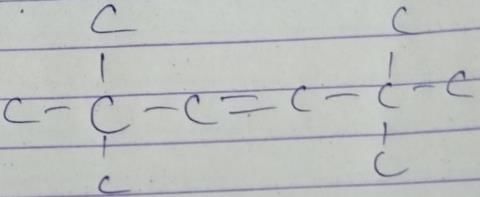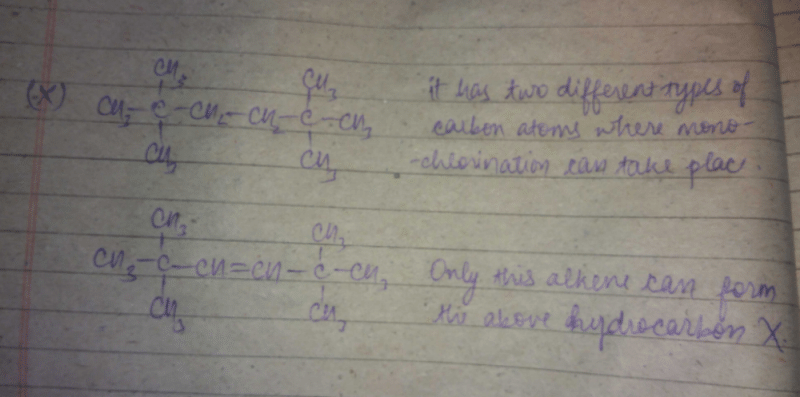Class 11 Exam > Class 11 Questions > A hydrocarbon with molecular formula C10H18, ...
Start Learning for Free
A hydrocarbon with molecular formula C10H18, upon catalytic hydrogenation gives C10H20 (X). X on free radical chlorination gives two monochloro derivatives with their molecular formula C10H19CI that are constitutional isomers.
Q. How many different alkenes on hydrogenation, can gives X ?
- a)1
- b)2
- c)3
- d)4
Correct answer is option 'A'. Can you explain this answer?
Verified Answer
A hydrocarbon with molecular formula C10H18, upon catalytic hydrogenat...

Most Upvoted Answer
A hydrocarbon with molecular formula C10H18, upon catalytic hydrogenat...

Free Test
FREE
| Start Free Test |
Community Answer
A hydrocarbon with molecular formula C10H18, upon catalytic hydrogenat...
Given:
- Molecular formula of hydrocarbon: C10H18
- Upon catalytic hydrogenation, it gives C10H20(X)
- X on free radical chlorination gives two monochloro derivatives with molecular formula C10H19Cl
To find:
Number of different alkenes on hydrogenation that can give X
Solution:
Step 1: Determine the degree of unsaturation
The molecular formula of the hydrocarbon is C10H18, which means there are (10*2 + 2) - 18 = 4 degrees of unsaturation. This indicates the presence of 4 rings or double bonds.
Step 2: Determine the possible structures of the hydrocarbon
Since the hydrocarbon has 4 degrees of unsaturation, there are several possibilities for its structure. We can start by drawing a structure with maximum rings and then add double bonds if needed.
Step 3: Draw the structure of the hydrocarbon
Considering the maximum number of rings, we can draw the structure of the hydrocarbon as follows:
H H H H H H H H H H
| | | | | | | | | |
H - C - C - C - C - C - C - C - C - C - C - H
| | | | | | | | | |
H H H H H H H H H H
This structure has 4 rings, which accounts for all 4 degrees of unsaturation.
Step 4: Perform catalytic hydrogenation
When the hydrocarbon undergoes catalytic hydrogenation, each double bond is converted into a single bond. Since there are no double bonds in the structure we drew, the catalytic hydrogenation will not result in any changes. Therefore, the product of the hydrogenation, C10H20(X), will remain the same as the starting hydrocarbon.
Step 5: Perform free radical chlorination
Upon free radical chlorination of X, two monochloro derivatives with molecular formula C10H19Cl are obtained. This means that there are two hydrogen atoms in X that can be replaced by chlorine.
Step 6: Determine the different alkenes that can give X on hydrogenation
Since the product of hydrogenation, C10H20(X), is the same as the starting hydrocarbon, there is only one alkene that can give X upon hydrogenation. This is because there is only one possible structure for the hydrocarbon with 4 degrees of unsaturation.
Therefore, the correct answer is option 'A', which states that there is only one different alkene that can give X on hydrogenation.
- Molecular formula of hydrocarbon: C10H18
- Upon catalytic hydrogenation, it gives C10H20(X)
- X on free radical chlorination gives two monochloro derivatives with molecular formula C10H19Cl
To find:
Number of different alkenes on hydrogenation that can give X
Solution:
Step 1: Determine the degree of unsaturation
The molecular formula of the hydrocarbon is C10H18, which means there are (10*2 + 2) - 18 = 4 degrees of unsaturation. This indicates the presence of 4 rings or double bonds.
Step 2: Determine the possible structures of the hydrocarbon
Since the hydrocarbon has 4 degrees of unsaturation, there are several possibilities for its structure. We can start by drawing a structure with maximum rings and then add double bonds if needed.
Step 3: Draw the structure of the hydrocarbon
Considering the maximum number of rings, we can draw the structure of the hydrocarbon as follows:
H H H H H H H H H H
| | | | | | | | | |
H - C - C - C - C - C - C - C - C - C - C - H
| | | | | | | | | |
H H H H H H H H H H
This structure has 4 rings, which accounts for all 4 degrees of unsaturation.
Step 4: Perform catalytic hydrogenation
When the hydrocarbon undergoes catalytic hydrogenation, each double bond is converted into a single bond. Since there are no double bonds in the structure we drew, the catalytic hydrogenation will not result in any changes. Therefore, the product of the hydrogenation, C10H20(X), will remain the same as the starting hydrocarbon.
Step 5: Perform free radical chlorination
Upon free radical chlorination of X, two monochloro derivatives with molecular formula C10H19Cl are obtained. This means that there are two hydrogen atoms in X that can be replaced by chlorine.
Step 6: Determine the different alkenes that can give X on hydrogenation
Since the product of hydrogenation, C10H20(X), is the same as the starting hydrocarbon, there is only one alkene that can give X upon hydrogenation. This is because there is only one possible structure for the hydrocarbon with 4 degrees of unsaturation.
Therefore, the correct answer is option 'A', which states that there is only one different alkene that can give X on hydrogenation.

|
Explore Courses for Class 11 exam
|

|
Question Description
A hydrocarbon with molecular formula C10H18, upon catalytic hydrogenation gives C10H20(X). X on free radical chlorination gives two monochloro derivatives with their molecular formula C10H19CI that are constitutional isomers.Q.How many different alkenes on hydrogenation, can gives X ?a)1b)2c)3d)4Correct answer is option 'A'. Can you explain this answer? for Class 11 2025 is part of Class 11 preparation. The Question and answers have been prepared according to the Class 11 exam syllabus. Information about A hydrocarbon with molecular formula C10H18, upon catalytic hydrogenation gives C10H20(X). X on free radical chlorination gives two monochloro derivatives with their molecular formula C10H19CI that are constitutional isomers.Q.How many different alkenes on hydrogenation, can gives X ?a)1b)2c)3d)4Correct answer is option 'A'. Can you explain this answer? covers all topics & solutions for Class 11 2025 Exam. Find important definitions, questions, meanings, examples, exercises and tests below for A hydrocarbon with molecular formula C10H18, upon catalytic hydrogenation gives C10H20(X). X on free radical chlorination gives two monochloro derivatives with their molecular formula C10H19CI that are constitutional isomers.Q.How many different alkenes on hydrogenation, can gives X ?a)1b)2c)3d)4Correct answer is option 'A'. Can you explain this answer?.
A hydrocarbon with molecular formula C10H18, upon catalytic hydrogenation gives C10H20(X). X on free radical chlorination gives two monochloro derivatives with their molecular formula C10H19CI that are constitutional isomers.Q.How many different alkenes on hydrogenation, can gives X ?a)1b)2c)3d)4Correct answer is option 'A'. Can you explain this answer? for Class 11 2025 is part of Class 11 preparation. The Question and answers have been prepared according to the Class 11 exam syllabus. Information about A hydrocarbon with molecular formula C10H18, upon catalytic hydrogenation gives C10H20(X). X on free radical chlorination gives two monochloro derivatives with their molecular formula C10H19CI that are constitutional isomers.Q.How many different alkenes on hydrogenation, can gives X ?a)1b)2c)3d)4Correct answer is option 'A'. Can you explain this answer? covers all topics & solutions for Class 11 2025 Exam. Find important definitions, questions, meanings, examples, exercises and tests below for A hydrocarbon with molecular formula C10H18, upon catalytic hydrogenation gives C10H20(X). X on free radical chlorination gives two monochloro derivatives with their molecular formula C10H19CI that are constitutional isomers.Q.How many different alkenes on hydrogenation, can gives X ?a)1b)2c)3d)4Correct answer is option 'A'. Can you explain this answer?.
Solutions for A hydrocarbon with molecular formula C10H18, upon catalytic hydrogenation gives C10H20(X). X on free radical chlorination gives two monochloro derivatives with their molecular formula C10H19CI that are constitutional isomers.Q.How many different alkenes on hydrogenation, can gives X ?a)1b)2c)3d)4Correct answer is option 'A'. Can you explain this answer? in English & in Hindi are available as part of our courses for Class 11.
Download more important topics, notes, lectures and mock test series for Class 11 Exam by signing up for free.
Here you can find the meaning of A hydrocarbon with molecular formula C10H18, upon catalytic hydrogenation gives C10H20(X). X on free radical chlorination gives two monochloro derivatives with their molecular formula C10H19CI that are constitutional isomers.Q.How many different alkenes on hydrogenation, can gives X ?a)1b)2c)3d)4Correct answer is option 'A'. Can you explain this answer? defined & explained in the simplest way possible. Besides giving the explanation of
A hydrocarbon with molecular formula C10H18, upon catalytic hydrogenation gives C10H20(X). X on free radical chlorination gives two monochloro derivatives with their molecular formula C10H19CI that are constitutional isomers.Q.How many different alkenes on hydrogenation, can gives X ?a)1b)2c)3d)4Correct answer is option 'A'. Can you explain this answer?, a detailed solution for A hydrocarbon with molecular formula C10H18, upon catalytic hydrogenation gives C10H20(X). X on free radical chlorination gives two monochloro derivatives with their molecular formula C10H19CI that are constitutional isomers.Q.How many different alkenes on hydrogenation, can gives X ?a)1b)2c)3d)4Correct answer is option 'A'. Can you explain this answer? has been provided alongside types of A hydrocarbon with molecular formula C10H18, upon catalytic hydrogenation gives C10H20(X). X on free radical chlorination gives two monochloro derivatives with their molecular formula C10H19CI that are constitutional isomers.Q.How many different alkenes on hydrogenation, can gives X ?a)1b)2c)3d)4Correct answer is option 'A'. Can you explain this answer? theory, EduRev gives you an
ample number of questions to practice A hydrocarbon with molecular formula C10H18, upon catalytic hydrogenation gives C10H20(X). X on free radical chlorination gives two monochloro derivatives with their molecular formula C10H19CI that are constitutional isomers.Q.How many different alkenes on hydrogenation, can gives X ?a)1b)2c)3d)4Correct answer is option 'A'. Can you explain this answer? tests, examples and also practice Class 11 tests.

|
Explore Courses for Class 11 exam
|

|
Signup for Free!
Signup to see your scores go up within 7 days! Learn & Practice with 1000+ FREE Notes, Videos & Tests.























